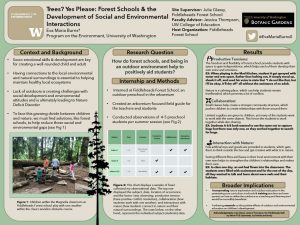TREES? YES PLEASE: FOREST SCHOOLS & THE DEVELOPMENT OF SOCIAL AND ENVIRONMENTAL INTERACTIONS
In recent years, there has been a growing concern that children are not spending enough time outside and are instead spending too much time inside on technology. Not only is this affecting their social development, but also their relationship to the environment. Forest Schools have been around since the 1950s and are viewed by many as a positive method of education. However, a lack of research has been done on the specific benefits of how forest schools could help children’s development of social and environmental awareness. The purpose of this study was to examine how forest schools, such as Fiddleheads Forest School in Seattle, positively aid the development of social and environmental interactions among young children. To accomplish this task, I created and utilized an observational chart, in which I surveyed 4-5 students during each of the three summer classes. The factors I observed included how children dealt with productive tensions, collaborated with one another and how they interacted with nature. The observations I made during my time at Fiddleheads Forest School were positive. They demonstrated that forest schools are a great educational environment for students to strengthen their social and environmental development. The constantly changing environment provides students with different situations that increase their ability to face challenges within themselves, and how they act towards others. While Forest Schools may have certain elements that aren’t necessarily suitable for all kids, there is great potential for many children to benefit from Forest Schools, or even from outdoor education.
